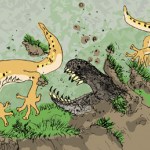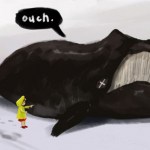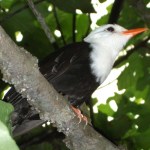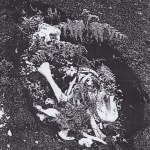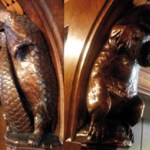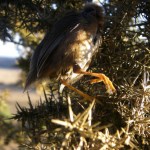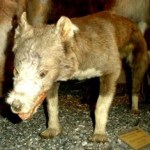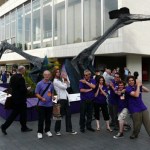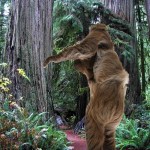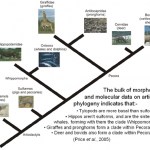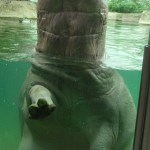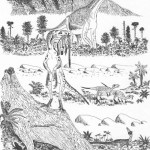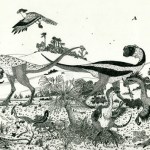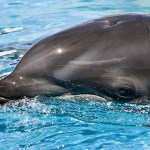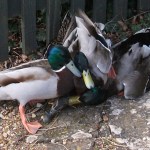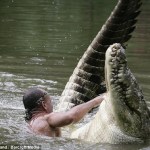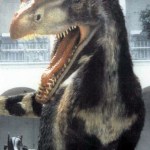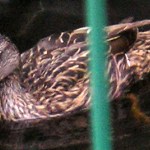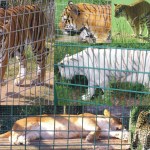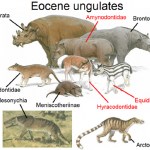picture of the day
When unable to find time to do anything else, resort to posting Squamozoic sneak-peeks (previous example here)...
This scene - 'Riverbank ambush' - features a giant macro-predatory amphisbaenian and some surprised gekkotans. Colouring by Tim Morris. Feel free to discuss among yourself. Kinda busy right now...
Borrowed from here on David's Really Interesting Pages (and used with permission: thanks David). A sort of homage to this article from last month.
Please identify. If possible, make it more interesting by saying something about the animal's behaviour, ecology and/or phylogenetic position (believe me, there is plenty to say). As usual, a smug sense of self-satisfaction to the winner.
Time for a little game. What does this photo represent? Can you work out what happened here? One clue: the skeleton belonged to a large mammal.
Sorry the pic is in black-and-white and a bit fuzzy, it's the best version of the image I have (a colour version exists somewhere - please do pass it on if you have it... UPDATE: thanks indeed to David Bressan of History of Geology). I've been looking for this photo for years (it was taken by Katia Krafft), and am grateful to Tony Butcher for passing it on after discovering it earlier this year.
UPDATE: Many thanks to everyone who had a go at…
While on holiday in Wales recently, we visited Cardiff Castle. Located within the grounds is the Victorian House, extensively transformed between the late 1860s and 1930s by William Burgess under John Crichton-Stuart, 3rd Marquess of Bute. I was quite surprised to find carved platypuses, armadillos, wombats and pangolins on some of the bookcases.
Apparently they commemorate particular countries of the then Commonwealth: any idea which countries armadillos and pangolins might be associated with? There were bears and otters, too. Sorry the photos aren't great. I couldn't use the flash, and…
A challenge for you (albeit another easy one): what species, and what activity, do these photos represent? I'll give you a few clues...
On second thoughts, I won't. Well, all I'll say is that the photos were taken in the New Forest in southern England and show one of the region's most famous birds. Tell me more!
Photos by Tara Dempsey, used with permission.
UPDATE (added 9th August 2010): Many thanks to all of you for your guesses. Many of you got it right, or mostly right. What we're looking at here is a juvenile Dartford warbler Sylvia undata, shown impaled on gorse spines. Admittedly,…
Test your skills and identify this carnivoran (sorry the image isn't larger: this is all I got). It's not meant to be particularly easy, so good luck. The person who supplied the image is not allowed to play, and it would be appreciated if another individual who has used the same image on his own blog refrained from spoiling things as well :)
I'll publish the answer within the next day or so. Good luck.
Darren is away. Back soon. Here are sneak-peeks...
The amazing freaky beast that's getting all the attention, that everyone gawps at in amazement (drumroll)...
... stands at centre-left in a white shirt. Yay, it's Witton's World of Pterosaurs. Photo above stolen from Benjamin Moon.
Dave Martill hard at work.
"Hey, it's Dave Hone, of Archosaur Musings!""Hey, it's Darren Naish, of Tet Zoo!".
Much more to come very soon...
This could be an opportunity to say something really smart and interesting, or it could be an excuse for silliness.
I leave you, my wise readers, to decide...
UPDATE: for those struggling to interpret the sloths, the image below should help. A shot of the sloths just a few moments later is shown on the right. These are Linnaeus's two-toed sloth Choloepus didactylus: in my opinion, three-toed sloths (Bradypus) look freakier because of their short snouts.
For previous Tet Zoo pieces on sloths, see...
Ten things you didn't know about sloths
The Panamanian Blue Hill Monster (or Cerro Azul…
Here's a very simplified 'consensus cladogram' for Artiodactyla: hey, just like it says in the title. Obviously, it only features living taxa. The reference cited on the side (it's a slide from a talk about hoofed mammal evolution) is...
Price, S. A., Bininda-Emonds, O. R. P. & Gittleman, J. L. 2005. A complete phylogeny of the whales, dolphins and even-toed hoofed mammals (Cetartiodactyla). Biological Reviews 80, 445-473.
Discuss!
Here's a pretty weird looking photo; it comes courtesy of Markus Bühler (of Bestiarium) and was taken at Berlin Zoo. I don't think I'm spoiling the surprise by saying that it shows a Hippopotamus amphibius....
... albeit a peculiar individual who seems to suffer from prolapsed tissue around the corners of her mouth. Initially I was going to use this view of a hippo to say something smart about the whippomorph hypothesis, but.. naaah. With a bit of photoshopping, I'm sure someone could make the picture look like it portrays some kind of horrendously ugly water monster. Maybe cropping the…
Another one. Identify the creatures (all from the Barremian Wessex Formation of the Isle of Wight, England) - possibly more difficult this time! Remember that some of the animals are in 'historic guise', so are portrayed very much inaccurately. And no cheating, as labelled versions of this picture have been published before (in the Japanese Dino Press magazine).
And sorry the image is so small: without publishing numerous close-ups, this is the only way I can get the whole image on the screen.
When I was a kid I drew lots of dinosaurs. My efforts weren't too bad, but of course I got a lot wrong (by modern standards) and - like so many dinosaur fan-boys and girls growing up in the 80s and 90s - I became a very good copier of Greg Paul. Here's a Late Cretaceous Mongolian scene I drew once (I cheated, as some of the animals shown here might never had met). Your challenge: name them.
As might be obvious, I always liked filling in all the little details. Plants, rocks, bugs and such. In fact, I always thought I might make a reasonably good mural artist: in Prehistoric Life Murals,…
Can you identify this peculiar odontocete? As always, dead easy. IF you know the answer. Thanks to Markus Bühler for the image.
Oh, and while I'm here...
On a completely different topic... I was once told that numerous birds die while flying close to or over offshore oil platforms [adjacent pic from wikipedia].
Supposedly, the birds are poisoned by the vented gases, and gather in some numbers on the decks. Is this complete nonsense, or might there be some truth to it? Can you provide more information? Having looked - and, believe me, I've spent a lot of time tracking down literature on…
Ducks - like the Mallards Anas platyrhynchos shown here - lead fairly violent sex lives. As I said in a previous article...
[A]s you'll know if you've spent any time watching ducks, 'forced extra-pair copulations' are very common in ducks. The Mallard Anas platyrhynchos is the best (or should that be worst?) example of the lot: females are handled so roughly by males (sometimes by groups of as many as 12) that it's quite common for people to speak of witnessing 'duck rape', and forced copulation is a common strategy used by males of this species.
Over the weekend I was fortunate enough to be…
What's going on in these pictures?
You might already know. If you do, feel free to spread the news.
Yes, yes there are.
Stay tuned, all will be revealed. And if you know what this is all about, and where it went and how it ended up and so on, please don't spoil it for everyone else. Yet.
Some days ago I went to the Isle of Wight Tiger and Lemur Sanctuary (which is where I saw all those big cats). And while there, one of the undoubted highlights was this amazing beast...
What is it, and what can you tell us about it? You get points for being clever, not for trying to be funny :)
No time for anything substantive, but here's a montage featuring some of the stuff we've been looking at while on holiday. Some of the cats here are rather unusual: the tiger in the middle of the top row was a Siberian x Chinese hybrid.
Getting good photos of the jaguars proved not so easy (see bottom right).
I know, I know: these are the sorts of animals you want to find out about, but just can't. Dinoceratans (much more than just Uintatherium Uintatherium Uintatherium), mesonychians, phenacodonts and arctocyonids. And what about pantodonts, tillodonts, taeniodonts.. and so much more? I know it's cruel, but one day I'll get round to them. One day. Consider this an annoying teaser.
Artwork by Michael Long, ZdenÄk Burian and Graham Allen.
For other articles on Paleogene placental mammals see...
Homage to The Velvet Claw (part I)
Giant killer pigs from hell
Snow White and the six perissodactyls…
